Analysis of Barriers to Implementing Lean Construction in Saudi Arabia
VerifiedAdded on 2019/09/25
|26
|10067
|54
Report
AI Summary
This report investigates the barriers to implementing lean construction practices within the Saudi Arabian construction industry. The study highlights the challenges faced, including the influence of traditional management approaches, lack of training and tools, organizational culture, and communication gaps. Through a questionnaire survey, the research identifies key barriers such as the dominance of traditional management, stakeholder involvement, and lack of technical knowledge. The report emphasizes the importance of addressing these barriers to improve project performance, reduce waste, and enhance efficiency. The findings underscore the need for a shift towards lean principles to overcome time delays, cost overruns, and quality issues, ultimately contributing to the modernization and improvement of the Saudi Arabian construction sector. The report also discusses the importance of government support, stakeholder involvement, and cost considerations for successful lean implementation.
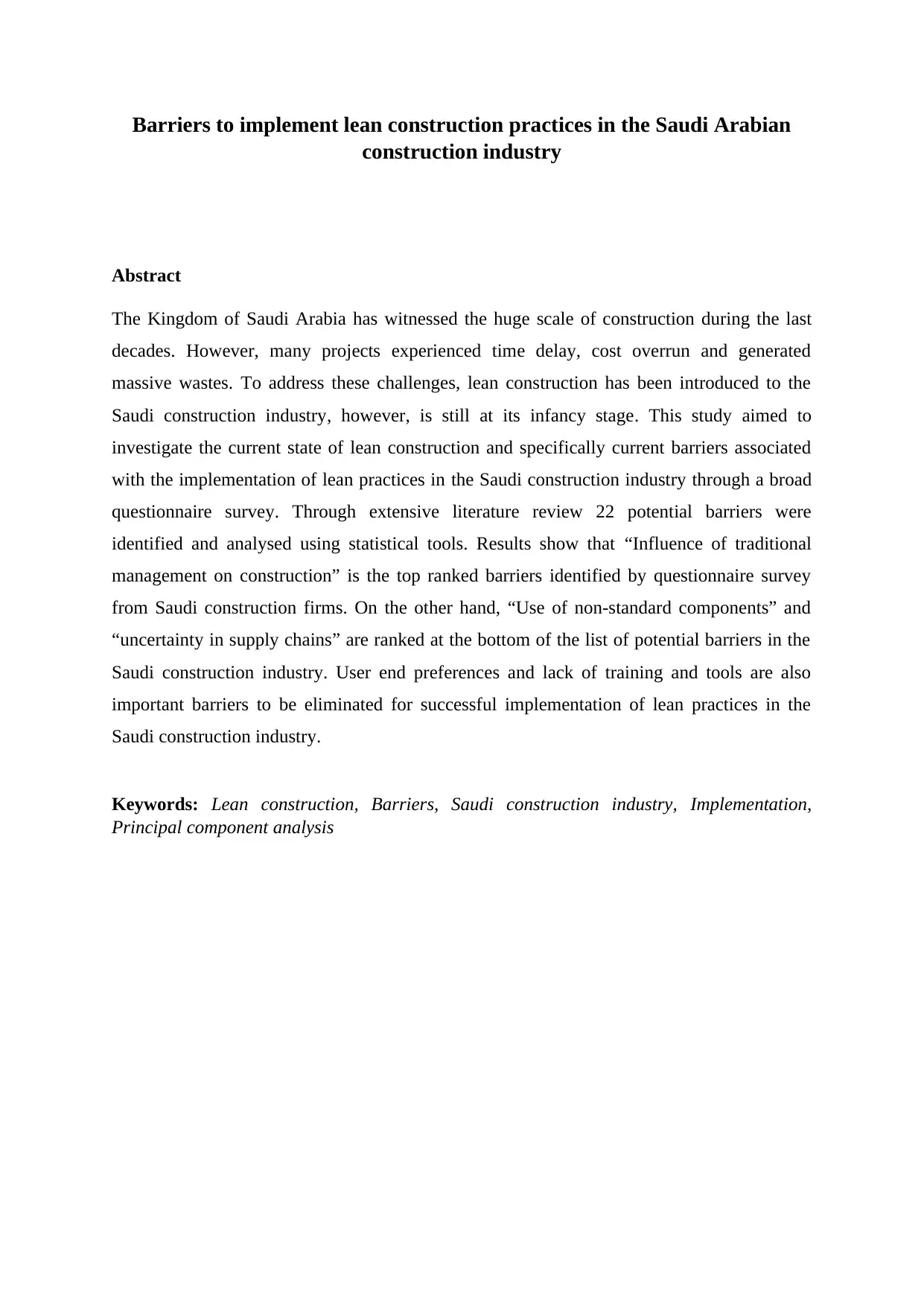
Barriers to implement lean construction practices in the Saudi Arabian
construction industry
Abstract
The Kingdom of Saudi Arabia has witnessed the huge scale of construction during the last
decades. However, many projects experienced time delay, cost overrun and generated
massive wastes. To address these challenges, lean construction has been introduced to the
Saudi construction industry, however, is still at its infancy stage. This study aimed to
investigate the current state of lean construction and specifically current barriers associated
with the implementation of lean practices in the Saudi construction industry through a broad
questionnaire survey. Through extensive literature review 22 potential barriers were
identified and analysed using statistical tools. Results show that “Influence of traditional
management on construction” is the top ranked barriers identified by questionnaire survey
from Saudi construction firms. On the other hand, “Use of non-standard components” and
“uncertainty in supply chains” are ranked at the bottom of the list of potential barriers in the
Saudi construction industry. User end preferences and lack of training and tools are also
important barriers to be eliminated for successful implementation of lean practices in the
Saudi construction industry.
Keywords: Lean construction, Barriers, Saudi construction industry, Implementation,
Principal component analysis
construction industry
Abstract
The Kingdom of Saudi Arabia has witnessed the huge scale of construction during the last
decades. However, many projects experienced time delay, cost overrun and generated
massive wastes. To address these challenges, lean construction has been introduced to the
Saudi construction industry, however, is still at its infancy stage. This study aimed to
investigate the current state of lean construction and specifically current barriers associated
with the implementation of lean practices in the Saudi construction industry through a broad
questionnaire survey. Through extensive literature review 22 potential barriers were
identified and analysed using statistical tools. Results show that “Influence of traditional
management on construction” is the top ranked barriers identified by questionnaire survey
from Saudi construction firms. On the other hand, “Use of non-standard components” and
“uncertainty in supply chains” are ranked at the bottom of the list of potential barriers in the
Saudi construction industry. User end preferences and lack of training and tools are also
important barriers to be eliminated for successful implementation of lean practices in the
Saudi construction industry.
Keywords: Lean construction, Barriers, Saudi construction industry, Implementation,
Principal component analysis
Paraphrase This Document
Need a fresh take? Get an instant paraphrase of this document with our AI Paraphraser
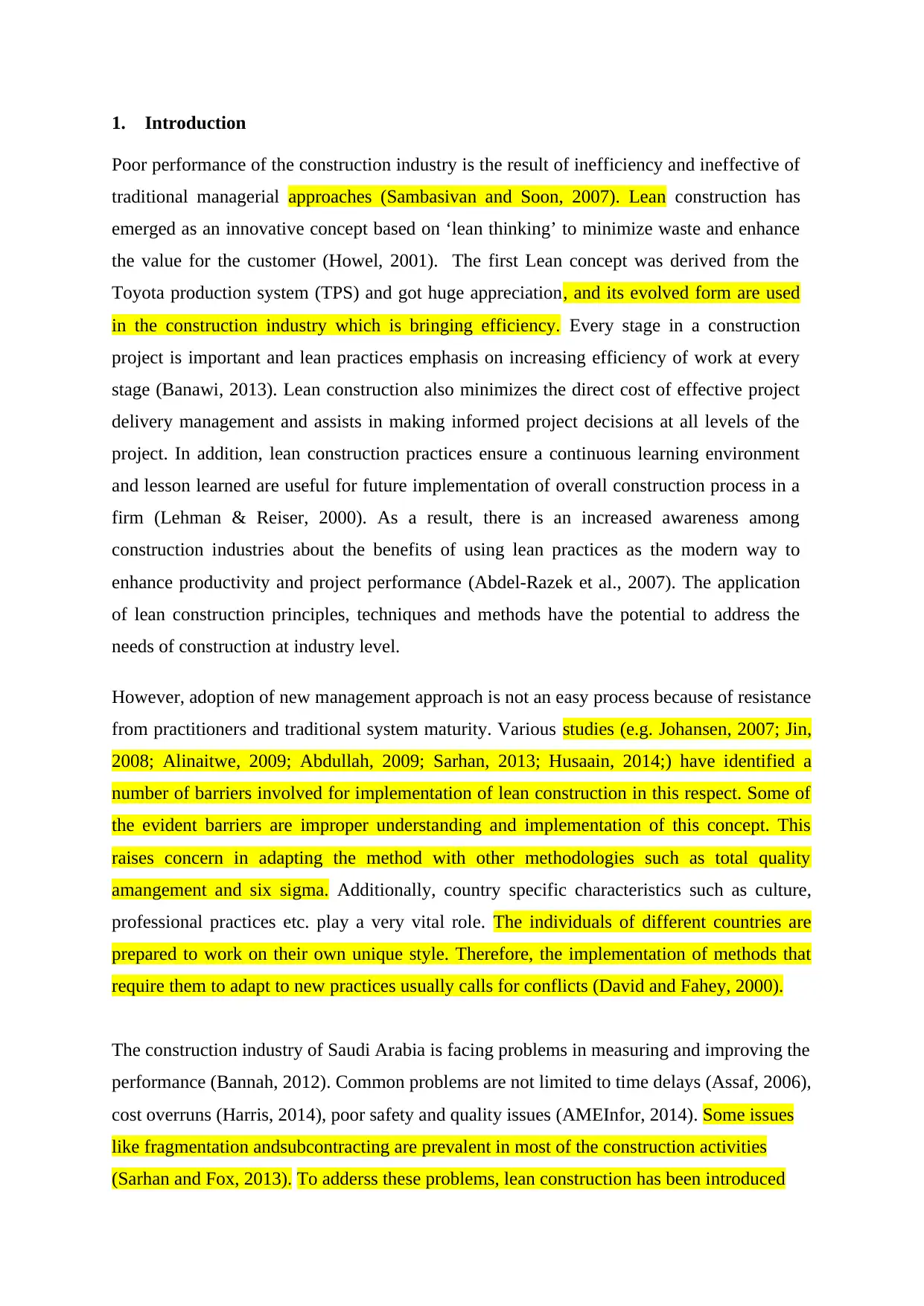
1. Introduction
Poor performance of the construction industry is the result of inefficiency and ineffective of
traditional managerial approaches (Sambasivan and Soon, 2007). Lean construction has
emerged as an innovative concept based on ‘lean thinking’ to minimize waste and enhance
the value for the customer (Howel, 2001). The first Lean concept was derived from the
Toyota production system (TPS) and got huge appreciation, and its evolved form are used
in the construction industry which is bringing efficiency. Every stage in a construction
project is important and lean practices emphasis on increasing efficiency of work at every
stage (Banawi, 2013). Lean construction also minimizes the direct cost of effective project
delivery management and assists in making informed project decisions at all levels of the
project. In addition, lean construction practices ensure a continuous learning environment
and lesson learned are useful for future implementation of overall construction process in a
firm (Lehman & Reiser, 2000). As a result, there is an increased awareness among
construction industries about the benefits of using lean practices as the modern way to
enhance productivity and project performance (Abdel-Razek et al., 2007). The application
of lean construction principles, techniques and methods have the potential to address the
needs of construction at industry level.
However, adoption of new management approach is not an easy process because of resistance
from practitioners and traditional system maturity. Various studies (e.g. Johansen, 2007; Jin,
2008; Alinaitwe, 2009; Abdullah, 2009; Sarhan, 2013; Husaain, 2014;) have identified a
number of barriers involved for implementation of lean construction in this respect. Some of
the evident barriers are improper understanding and implementation of this concept. This
raises concern in adapting the method with other methodologies such as total quality
amangement and six sigma. Additionally, country specific characteristics such as culture,
professional practices etc. play a very vital role. The individuals of different countries are
prepared to work on their own unique style. Therefore, the implementation of methods that
require them to adapt to new practices usually calls for conflicts (David and Fahey, 2000).
The construction industry of Saudi Arabia is facing problems in measuring and improving the
performance (Bannah, 2012). Common problems are not limited to time delays (Assaf, 2006),
cost overruns (Harris, 2014), poor safety and quality issues (AMEInfor, 2014). Some issues
like fragmentation andsubcontracting are prevalent in most of the construction activities
(Sarhan and Fox, 2013). To adderss these problems, lean construction has been introduced
Poor performance of the construction industry is the result of inefficiency and ineffective of
traditional managerial approaches (Sambasivan and Soon, 2007). Lean construction has
emerged as an innovative concept based on ‘lean thinking’ to minimize waste and enhance
the value for the customer (Howel, 2001). The first Lean concept was derived from the
Toyota production system (TPS) and got huge appreciation, and its evolved form are used
in the construction industry which is bringing efficiency. Every stage in a construction
project is important and lean practices emphasis on increasing efficiency of work at every
stage (Banawi, 2013). Lean construction also minimizes the direct cost of effective project
delivery management and assists in making informed project decisions at all levels of the
project. In addition, lean construction practices ensure a continuous learning environment
and lesson learned are useful for future implementation of overall construction process in a
firm (Lehman & Reiser, 2000). As a result, there is an increased awareness among
construction industries about the benefits of using lean practices as the modern way to
enhance productivity and project performance (Abdel-Razek et al., 2007). The application
of lean construction principles, techniques and methods have the potential to address the
needs of construction at industry level.
However, adoption of new management approach is not an easy process because of resistance
from practitioners and traditional system maturity. Various studies (e.g. Johansen, 2007; Jin,
2008; Alinaitwe, 2009; Abdullah, 2009; Sarhan, 2013; Husaain, 2014;) have identified a
number of barriers involved for implementation of lean construction in this respect. Some of
the evident barriers are improper understanding and implementation of this concept. This
raises concern in adapting the method with other methodologies such as total quality
amangement and six sigma. Additionally, country specific characteristics such as culture,
professional practices etc. play a very vital role. The individuals of different countries are
prepared to work on their own unique style. Therefore, the implementation of methods that
require them to adapt to new practices usually calls for conflicts (David and Fahey, 2000).
The construction industry of Saudi Arabia is facing problems in measuring and improving the
performance (Bannah, 2012). Common problems are not limited to time delays (Assaf, 2006),
cost overruns (Harris, 2014), poor safety and quality issues (AMEInfor, 2014). Some issues
like fragmentation andsubcontracting are prevalent in most of the construction activities
(Sarhan and Fox, 2013). To adderss these problems, lean construction has been introduced
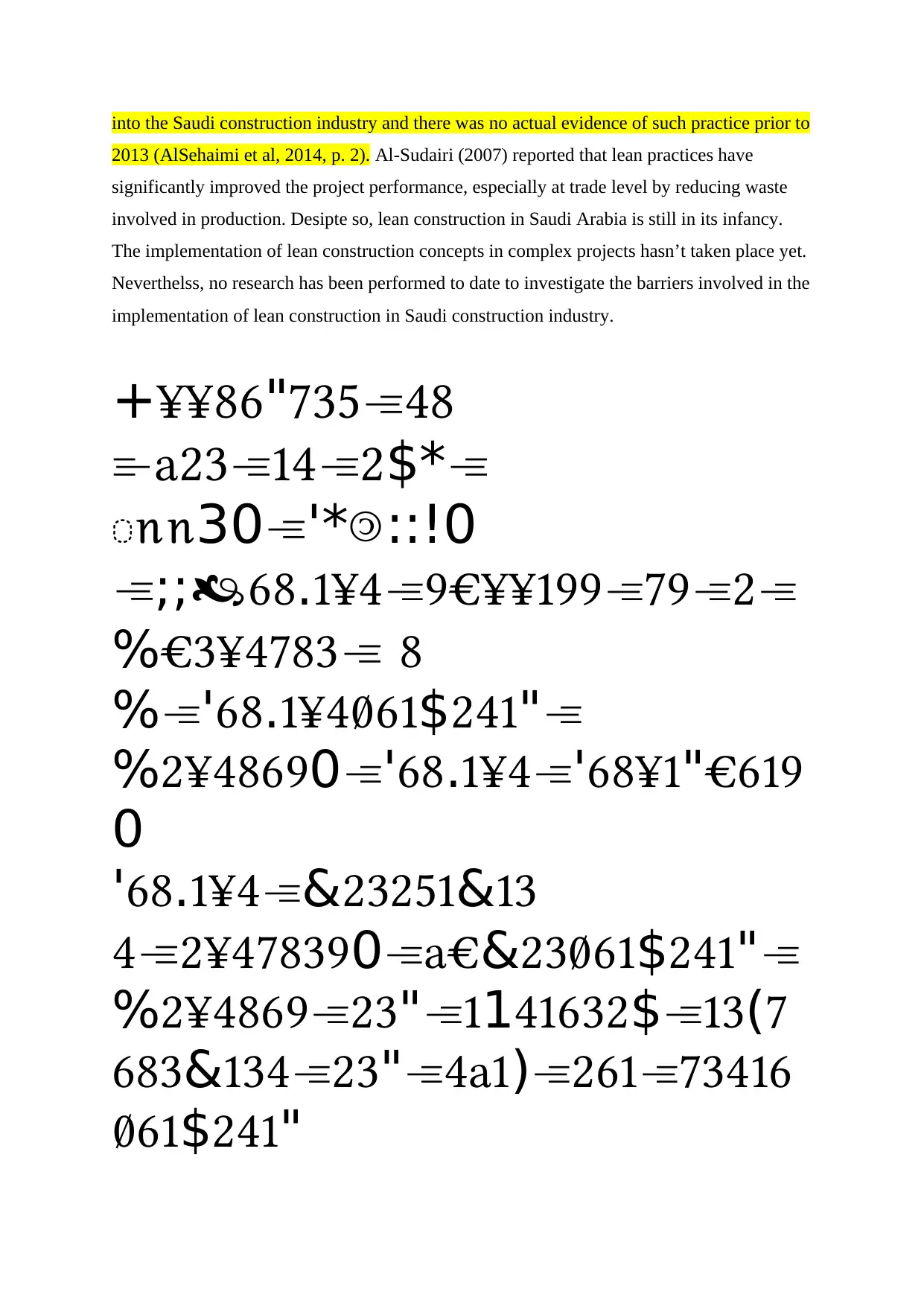
into the Saudi construction industry and there was no actual evidence of such practice prior to
2013 (AlSehaimi et al, 2014, p. 2). Al-Sudairi (2007) reported that lean practices have
significantly improved the project performance, especially at trade level by reducing waste
involved in production. Desipte so, lean construction in Saudi Arabia is still in its infancy.
The implementation of lean construction concepts in complex projects hasn’t taken place yet.
Neverthelss, no research has been performed to date to investigate the barriers involved in the
implementation of lean construction in Saudi construction industry.
+ "
$*
30 '* ::!0
;; .
%
% ' . $ "
% 0 ' . ' "
0
' . & &
0 & $ "
% " 1 $ (
& " )
$ "
2013 (AlSehaimi et al, 2014, p. 2). Al-Sudairi (2007) reported that lean practices have
significantly improved the project performance, especially at trade level by reducing waste
involved in production. Desipte so, lean construction in Saudi Arabia is still in its infancy.
The implementation of lean construction concepts in complex projects hasn’t taken place yet.
Neverthelss, no research has been performed to date to investigate the barriers involved in the
implementation of lean construction in Saudi construction industry.
+ "
$*
30 '* ::!0
;; .
%
% ' . $ "
% 0 ' . ' "
0
' . & &
0 & $ "
% " 1 $ (
& " )
$ "
⊘ This is a preview!⊘
Do you want full access?
Subscribe today to unlock all pages.

Trusted by 1+ million students worldwide

" $ "<*
+ "
$*
30 '* ::!0
;; .
%
% ' . $ "
% 0 ' . ' "
0
' . & &
0 & $ "
% " 1 $ (
& " )
$ "
" $ "<*
Therfore this paper aims to understand what hinders the implementation of lean construction
practices in the Saudi construction industry. Using a broad questionnaire survey, different
barriers and challenges will be identified. The findings of this research will help different
stakeholders better understand and overcome such barriers, specifically those highly
+ "
$*
30 '* ::!0
;; .
%
% ' . $ "
% 0 ' . ' "
0
' . & &
0 & $ "
% " 1 $ (
& " )
$ "
" $ "<*
Therfore this paper aims to understand what hinders the implementation of lean construction
practices in the Saudi construction industry. Using a broad questionnaire survey, different
barriers and challenges will be identified. The findings of this research will help different
stakeholders better understand and overcome such barriers, specifically those highly
Paraphrase This Document
Need a fresh take? Get an instant paraphrase of this document with our AI Paraphraser
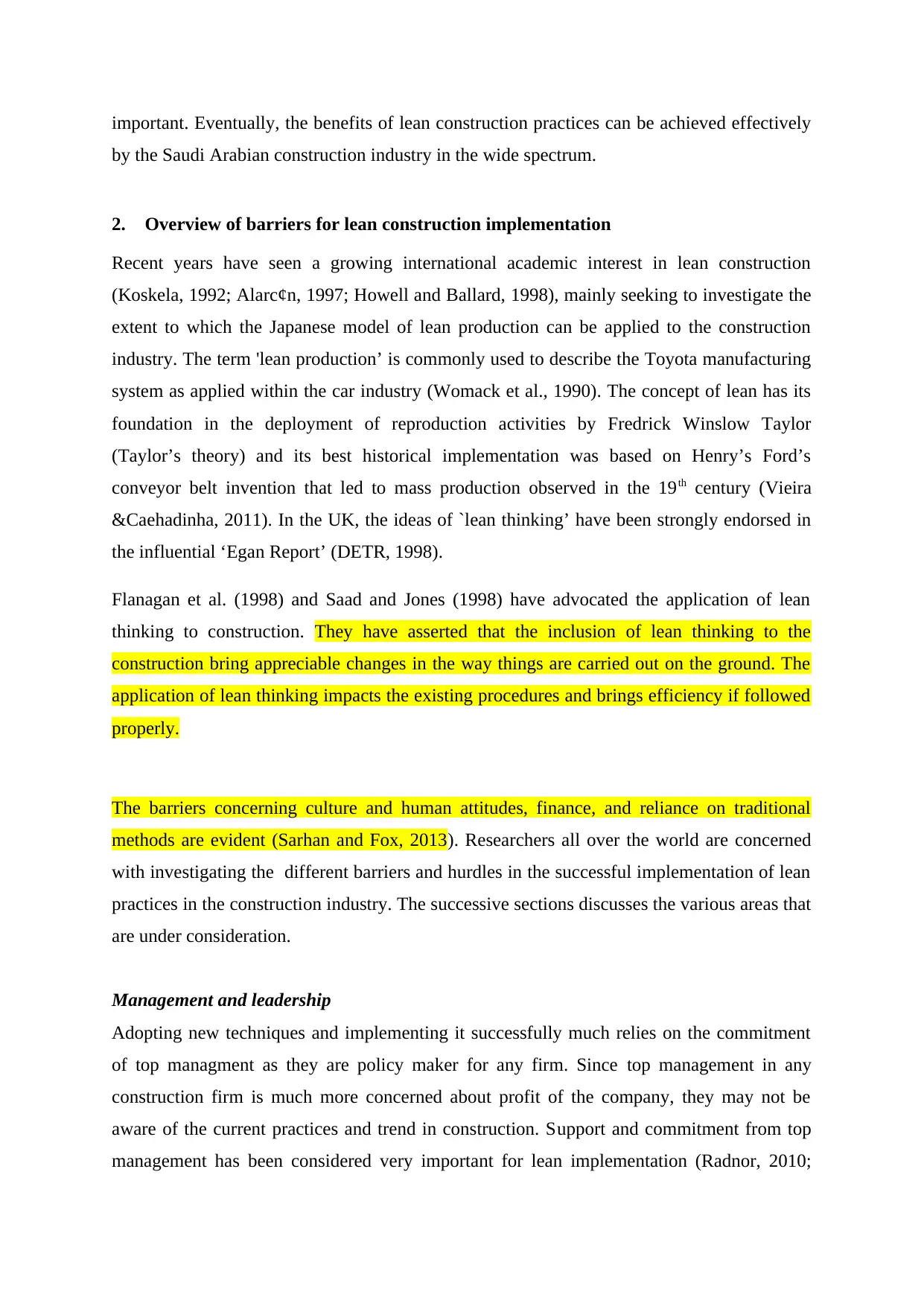
important. Eventually, the benefits of lean construction practices can be achieved effectively
by the Saudi Arabian construction industry in the wide spectrum.
2. Overview of barriers for lean construction implementation
Recent years have seen a growing international academic interest in lean construction
(Koskela, 1992; Alarc¢n, 1997; Howell and Ballard, 1998), mainly seeking to investigate the
extent to which the Japanese model of lean production can be applied to the construction
industry. The term 'lean production’ is commonly used to describe the Toyota manufacturing
system as applied within the car industry (Womack et al., 1990). The concept of lean has its
foundation in the deployment of reproduction activities by Fredrick Winslow Taylor
(Taylor’s theory) and its best historical implementation was based on Henry’s Ford’s
conveyor belt invention that led to mass production observed in the 19th century (Vieira
&Caehadinha, 2011). In the UK, the ideas of `lean thinking’ have been strongly endorsed in
the influential ‘Egan Report’ (DETR, 1998).
Flanagan et al. (1998) and Saad and Jones (1998) have advocated the application of lean
thinking to construction. They have asserted that the inclusion of lean thinking to the
construction bring appreciable changes in the way things are carried out on the ground. The
application of lean thinking impacts the existing procedures and brings efficiency if followed
properly.
The barriers concerning culture and human attitudes, finance, and reliance on traditional
methods are evident (Sarhan and Fox, 2013). Researchers all over the world are concerned
with investigating the different barriers and hurdles in the successful implementation of lean
practices in the construction industry. The successive sections discusses the various areas that
are under consideration.
Management and leadership
Adopting new techniques and implementing it successfully much relies on the commitment
of top managment as they are policy maker for any firm. Since top management in any
construction firm is much more concerned about profit of the company, they may not be
aware of the current practices and trend in construction. Support and commitment from top
management has been considered very important for lean implementation (Radnor, 2010;
by the Saudi Arabian construction industry in the wide spectrum.
2. Overview of barriers for lean construction implementation
Recent years have seen a growing international academic interest in lean construction
(Koskela, 1992; Alarc¢n, 1997; Howell and Ballard, 1998), mainly seeking to investigate the
extent to which the Japanese model of lean production can be applied to the construction
industry. The term 'lean production’ is commonly used to describe the Toyota manufacturing
system as applied within the car industry (Womack et al., 1990). The concept of lean has its
foundation in the deployment of reproduction activities by Fredrick Winslow Taylor
(Taylor’s theory) and its best historical implementation was based on Henry’s Ford’s
conveyor belt invention that led to mass production observed in the 19th century (Vieira
&Caehadinha, 2011). In the UK, the ideas of `lean thinking’ have been strongly endorsed in
the influential ‘Egan Report’ (DETR, 1998).
Flanagan et al. (1998) and Saad and Jones (1998) have advocated the application of lean
thinking to construction. They have asserted that the inclusion of lean thinking to the
construction bring appreciable changes in the way things are carried out on the ground. The
application of lean thinking impacts the existing procedures and brings efficiency if followed
properly.
The barriers concerning culture and human attitudes, finance, and reliance on traditional
methods are evident (Sarhan and Fox, 2013). Researchers all over the world are concerned
with investigating the different barriers and hurdles in the successful implementation of lean
practices in the construction industry. The successive sections discusses the various areas that
are under consideration.
Management and leadership
Adopting new techniques and implementing it successfully much relies on the commitment
of top managment as they are policy maker for any firm. Since top management in any
construction firm is much more concerned about profit of the company, they may not be
aware of the current practices and trend in construction. Support and commitment from top
management has been considered very important for lean implementation (Radnor, 2010;

Suárez-Barraza and Ramis-Pujol, 2010), and specifically necessary element in implementing
Just in Time (JIT) and Total Quality Management (TQM) in construction (Low and Teo,
2004; Low and Chan, 1997). Otherwise, some management policies may hinder in successful
implementation of proper lean practices, which has been observed and discussed in Germany
and Finland construction industry (Johansen & Walter, 2007; Koskela, 1997).
Organizational culture
Organizational culture is of great importance to people and they normally don’t want to
change it. They prefer staying in the comfort zone for long (Hornstein, 2015). The inclusion
of lean methods would call them to get out of their comfort zone and adapt to something new.
Such changes are bound to face resistance from these employees or people. A lean culture has
specific dimensions that define the behaviour of the employees (Womack and Jones, 1996)
This requires a different attitude and can be sometime difficult to follow through if one is
unaware of the importance and activities under consideration.
People don’t want change and it’s difficult to convince someone to adopt a new practice and
leave what they used to do for a very long time. In order to adopt lean practices workers are
asked to follow new production systems, working relationships, expectations about
productivity, quality. All of these can be scary and uncomfortable for workers (Sim and
Rogers, 2009; de Souza and Pidd, 2011). There are many stakeholders in a complex
organizational hierarchy of any big construction firm.
Techincal knowledge
Lean construction is a relatively new concept and it needs proper understanding and
sufficient konwldge for its implementation..It has been observed in many construction firms
that they want to adopt lean construction practice, but not skilled enough and did not have
enough training to adopt new tools in their firms. In order to successfully implement lean
construction in any construction firm, there should be a proper understanding of the technical
issues and all the steps involved. Special training and skills are required, for example to run a
software for better implementation (Liker, 2004). Lack of technical knowledge is one of the
greatest barriers identified by the Lean Enterprise Institute (LEI) in its 2007 survey. If a
construction firm adopts lean construction practice, but there are deficiencies in technical
sector and they are not adopting complete technical tools, then the results will not be much
fruitful (Liker, 2004). The traditional design and construction approach is very much different
Just in Time (JIT) and Total Quality Management (TQM) in construction (Low and Teo,
2004; Low and Chan, 1997). Otherwise, some management policies may hinder in successful
implementation of proper lean practices, which has been observed and discussed in Germany
and Finland construction industry (Johansen & Walter, 2007; Koskela, 1997).
Organizational culture
Organizational culture is of great importance to people and they normally don’t want to
change it. They prefer staying in the comfort zone for long (Hornstein, 2015). The inclusion
of lean methods would call them to get out of their comfort zone and adapt to something new.
Such changes are bound to face resistance from these employees or people. A lean culture has
specific dimensions that define the behaviour of the employees (Womack and Jones, 1996)
This requires a different attitude and can be sometime difficult to follow through if one is
unaware of the importance and activities under consideration.
People don’t want change and it’s difficult to convince someone to adopt a new practice and
leave what they used to do for a very long time. In order to adopt lean practices workers are
asked to follow new production systems, working relationships, expectations about
productivity, quality. All of these can be scary and uncomfortable for workers (Sim and
Rogers, 2009; de Souza and Pidd, 2011). There are many stakeholders in a complex
organizational hierarchy of any big construction firm.
Techincal knowledge
Lean construction is a relatively new concept and it needs proper understanding and
sufficient konwldge for its implementation..It has been observed in many construction firms
that they want to adopt lean construction practice, but not skilled enough and did not have
enough training to adopt new tools in their firms. In order to successfully implement lean
construction in any construction firm, there should be a proper understanding of the technical
issues and all the steps involved. Special training and skills are required, for example to run a
software for better implementation (Liker, 2004). Lack of technical knowledge is one of the
greatest barriers identified by the Lean Enterprise Institute (LEI) in its 2007 survey. If a
construction firm adopts lean construction practice, but there are deficiencies in technical
sector and they are not adopting complete technical tools, then the results will not be much
fruitful (Liker, 2004). The traditional design and construction approach is very much different
⊘ This is a preview!⊘
Do you want full access?
Subscribe today to unlock all pages.

Trusted by 1+ million students worldwide

and does not go along with lean concept. Thus it is difficult to implement lean concepts with
accordance to traditional practices (Liker, 2004; Tam et al., 2011).
Communication
Effective communication within different teams is very important for successful
implementation of lean construction practices. But it has been observed that there is a
communication gap between different teams as there is no proper channel and strategy for
this purpose. This barrier has been identified and discussed in the Malaysian construction
industry (Ong, 2013).
Performance measurement
Lean construction principles require a proper check on the performance levels. Most of the
companies lack in this area and adopting lean construction ineffectively (Sarhan, Fox, 2013)
Stakeholder involvement
Lean construction requires proper planning, training, skills and tools for every stage of
construction. The involvement of stakeholders in an effective manner becomes imperative for
the project success. Moreover, the implementation of lean construction method will require
time and many firms don’t want to spend this much time period for turning to something new
and unknown (Sim and Rogers, 2009; de Souza and Pidd, 2011). There has been observed a
lack in interest of client and suppliers and they are less involved in the whole process.
Clients are non-technical people and sometimes there is a communication gap which will
cause problems in later stages of the project. And it is also observed sometimes clients
change their requirements during the construction phase and it alters the whole scope of the
project. These types of barriers also impact implementation of lean construction (Jha & Iyer,
2006; Shang & Sui Phen, 2014). Benchmarks are important to set the proper pace in the work
and achieving levels of success required. There is lack in providing proper benchmarks in the
project and causing mismanagements in the resources (Ong, 2013). Moreover, it helps the
stakeholders in assessing the project success based on the predefined benchmarks. In order to
implement any new practice, support from government is very important and plays a vital
role. The government makes new polices and sometimes proper fund issues for government
organizations for such purposes. Lack of support from government is identified as a barrier in
accordance to traditional practices (Liker, 2004; Tam et al., 2011).
Communication
Effective communication within different teams is very important for successful
implementation of lean construction practices. But it has been observed that there is a
communication gap between different teams as there is no proper channel and strategy for
this purpose. This barrier has been identified and discussed in the Malaysian construction
industry (Ong, 2013).
Performance measurement
Lean construction principles require a proper check on the performance levels. Most of the
companies lack in this area and adopting lean construction ineffectively (Sarhan, Fox, 2013)
Stakeholder involvement
Lean construction requires proper planning, training, skills and tools for every stage of
construction. The involvement of stakeholders in an effective manner becomes imperative for
the project success. Moreover, the implementation of lean construction method will require
time and many firms don’t want to spend this much time period for turning to something new
and unknown (Sim and Rogers, 2009; de Souza and Pidd, 2011). There has been observed a
lack in interest of client and suppliers and they are less involved in the whole process.
Clients are non-technical people and sometimes there is a communication gap which will
cause problems in later stages of the project. And it is also observed sometimes clients
change their requirements during the construction phase and it alters the whole scope of the
project. These types of barriers also impact implementation of lean construction (Jha & Iyer,
2006; Shang & Sui Phen, 2014). Benchmarks are important to set the proper pace in the work
and achieving levels of success required. There is lack in providing proper benchmarks in the
project and causing mismanagements in the resources (Ong, 2013). Moreover, it helps the
stakeholders in assessing the project success based on the predefined benchmarks. In order to
implement any new practice, support from government is very important and plays a vital
role. The government makes new polices and sometimes proper fund issues for government
organizations for such purposes. Lack of support from government is identified as a barrier in
Paraphrase This Document
Need a fresh take? Get an instant paraphrase of this document with our AI Paraphraser
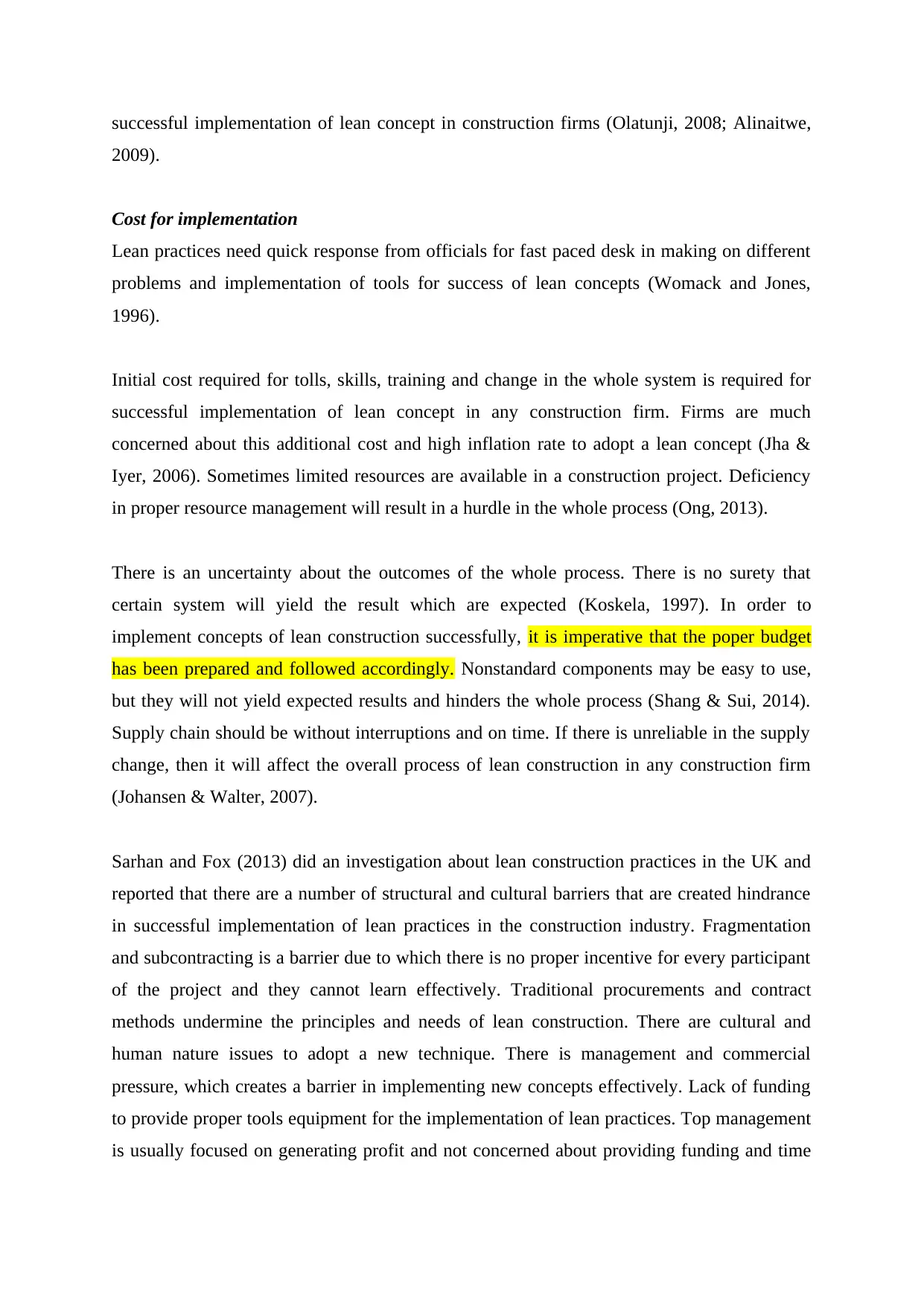
successful implementation of lean concept in construction firms (Olatunji, 2008; Alinaitwe,
2009).
Cost for implementation
Lean practices need quick response from officials for fast paced desk in making on different
problems and implementation of tools for success of lean concepts (Womack and Jones,
1996).
Initial cost required for tolls, skills, training and change in the whole system is required for
successful implementation of lean concept in any construction firm. Firms are much
concerned about this additional cost and high inflation rate to adopt a lean concept (Jha &
Iyer, 2006). Sometimes limited resources are available in a construction project. Deficiency
in proper resource management will result in a hurdle in the whole process (Ong, 2013).
There is an uncertainty about the outcomes of the whole process. There is no surety that
certain system will yield the result which are expected (Koskela, 1997). In order to
implement concepts of lean construction successfully, it is imperative that the poper budget
has been prepared and followed accordingly. Nonstandard components may be easy to use,
but they will not yield expected results and hinders the whole process (Shang & Sui, 2014).
Supply chain should be without interruptions and on time. If there is unreliable in the supply
change, then it will affect the overall process of lean construction in any construction firm
(Johansen & Walter, 2007).
Sarhan and Fox (2013) did an investigation about lean construction practices in the UK and
reported that there are a number of structural and cultural barriers that are created hindrance
in successful implementation of lean practices in the construction industry. Fragmentation
and subcontracting is a barrier due to which there is no proper incentive for every participant
of the project and they cannot learn effectively. Traditional procurements and contract
methods undermine the principles and needs of lean construction. There are cultural and
human nature issues to adopt a new technique. There is management and commercial
pressure, which creates a barrier in implementing new concepts effectively. Lack of funding
to provide proper tools equipment for the implementation of lean practices. Top management
is usually focused on generating profit and not concerned about providing funding and time
2009).
Cost for implementation
Lean practices need quick response from officials for fast paced desk in making on different
problems and implementation of tools for success of lean concepts (Womack and Jones,
1996).
Initial cost required for tolls, skills, training and change in the whole system is required for
successful implementation of lean concept in any construction firm. Firms are much
concerned about this additional cost and high inflation rate to adopt a lean concept (Jha &
Iyer, 2006). Sometimes limited resources are available in a construction project. Deficiency
in proper resource management will result in a hurdle in the whole process (Ong, 2013).
There is an uncertainty about the outcomes of the whole process. There is no surety that
certain system will yield the result which are expected (Koskela, 1997). In order to
implement concepts of lean construction successfully, it is imperative that the poper budget
has been prepared and followed accordingly. Nonstandard components may be easy to use,
but they will not yield expected results and hinders the whole process (Shang & Sui, 2014).
Supply chain should be without interruptions and on time. If there is unreliable in the supply
change, then it will affect the overall process of lean construction in any construction firm
(Johansen & Walter, 2007).
Sarhan and Fox (2013) did an investigation about lean construction practices in the UK and
reported that there are a number of structural and cultural barriers that are created hindrance
in successful implementation of lean practices in the construction industry. Fragmentation
and subcontracting is a barrier due to which there is no proper incentive for every participant
of the project and they cannot learn effectively. Traditional procurements and contract
methods undermine the principles and needs of lean construction. There are cultural and
human nature issues to adopt a new technique. There is management and commercial
pressure, which creates a barrier in implementing new concepts effectively. Lack of funding
to provide proper tools equipment for the implementation of lean practices. Top management
is usually focused on generating profit and not concerned about providing funding and time
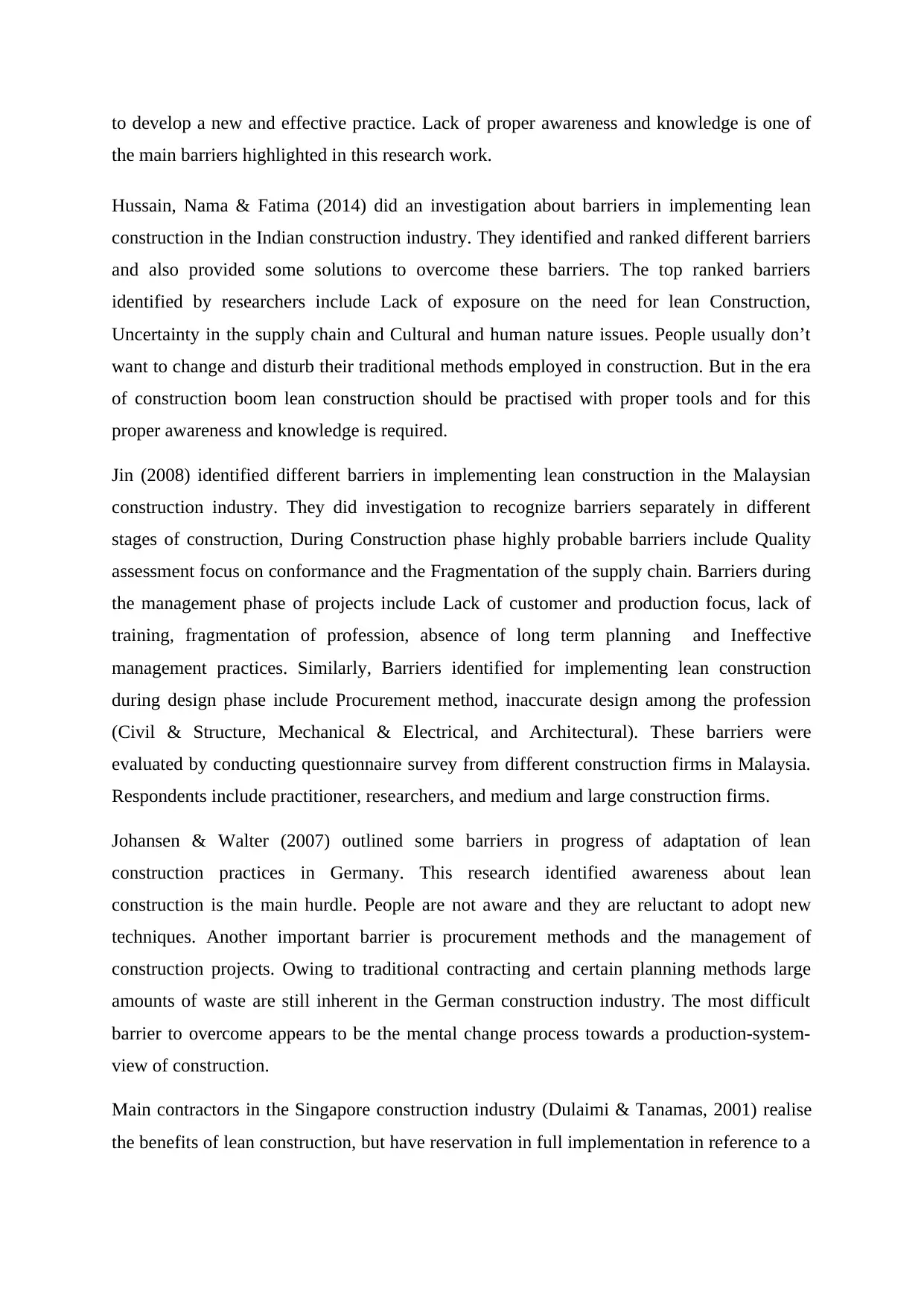
to develop a new and effective practice. Lack of proper awareness and knowledge is one of
the main barriers highlighted in this research work.
Hussain, Nama & Fatima (2014) did an investigation about barriers in implementing lean
construction in the Indian construction industry. They identified and ranked different barriers
and also provided some solutions to overcome these barriers. The top ranked barriers
identified by researchers include Lack of exposure on the need for lean Construction,
Uncertainty in the supply chain and Cultural and human nature issues. People usually don’t
want to change and disturb their traditional methods employed in construction. But in the era
of construction boom lean construction should be practised with proper tools and for this
proper awareness and knowledge is required.
Jin (2008) identified different barriers in implementing lean construction in the Malaysian
construction industry. They did investigation to recognize barriers separately in different
stages of construction, During Construction phase highly probable barriers include Quality
assessment focus on conformance and the Fragmentation of the supply chain. Barriers during
the management phase of projects include Lack of customer and production focus, lack of
training, fragmentation of profession, absence of long term planning and Ineffective
management practices. Similarly, Barriers identified for implementing lean construction
during design phase include Procurement method, inaccurate design among the profession
(Civil & Structure, Mechanical & Electrical, and Architectural). These barriers were
evaluated by conducting questionnaire survey from different construction firms in Malaysia.
Respondents include practitioner, researchers, and medium and large construction firms.
Johansen & Walter (2007) outlined some barriers in progress of adaptation of lean
construction practices in Germany. This research identified awareness about lean
construction is the main hurdle. People are not aware and they are reluctant to adopt new
techniques. Another important barrier is procurement methods and the management of
construction projects. Owing to traditional contracting and certain planning methods large
amounts of waste are still inherent in the German construction industry. The most difficult
barrier to overcome appears to be the mental change process towards a production-system-
view of construction.
Main contractors in the Singapore construction industry (Dulaimi & Tanamas, 2001) realise
the benefits of lean construction, but have reservation in full implementation in reference to a
the main barriers highlighted in this research work.
Hussain, Nama & Fatima (2014) did an investigation about barriers in implementing lean
construction in the Indian construction industry. They identified and ranked different barriers
and also provided some solutions to overcome these barriers. The top ranked barriers
identified by researchers include Lack of exposure on the need for lean Construction,
Uncertainty in the supply chain and Cultural and human nature issues. People usually don’t
want to change and disturb their traditional methods employed in construction. But in the era
of construction boom lean construction should be practised with proper tools and for this
proper awareness and knowledge is required.
Jin (2008) identified different barriers in implementing lean construction in the Malaysian
construction industry. They did investigation to recognize barriers separately in different
stages of construction, During Construction phase highly probable barriers include Quality
assessment focus on conformance and the Fragmentation of the supply chain. Barriers during
the management phase of projects include Lack of customer and production focus, lack of
training, fragmentation of profession, absence of long term planning and Ineffective
management practices. Similarly, Barriers identified for implementing lean construction
during design phase include Procurement method, inaccurate design among the profession
(Civil & Structure, Mechanical & Electrical, and Architectural). These barriers were
evaluated by conducting questionnaire survey from different construction firms in Malaysia.
Respondents include practitioner, researchers, and medium and large construction firms.
Johansen & Walter (2007) outlined some barriers in progress of adaptation of lean
construction practices in Germany. This research identified awareness about lean
construction is the main hurdle. People are not aware and they are reluctant to adopt new
techniques. Another important barrier is procurement methods and the management of
construction projects. Owing to traditional contracting and certain planning methods large
amounts of waste are still inherent in the German construction industry. The most difficult
barrier to overcome appears to be the mental change process towards a production-system-
view of construction.
Main contractors in the Singapore construction industry (Dulaimi & Tanamas, 2001) realise
the benefits of lean construction, but have reservation in full implementation in reference to a
⊘ This is a preview!⊘
Do you want full access?
Subscribe today to unlock all pages.

Trusted by 1+ million students worldwide
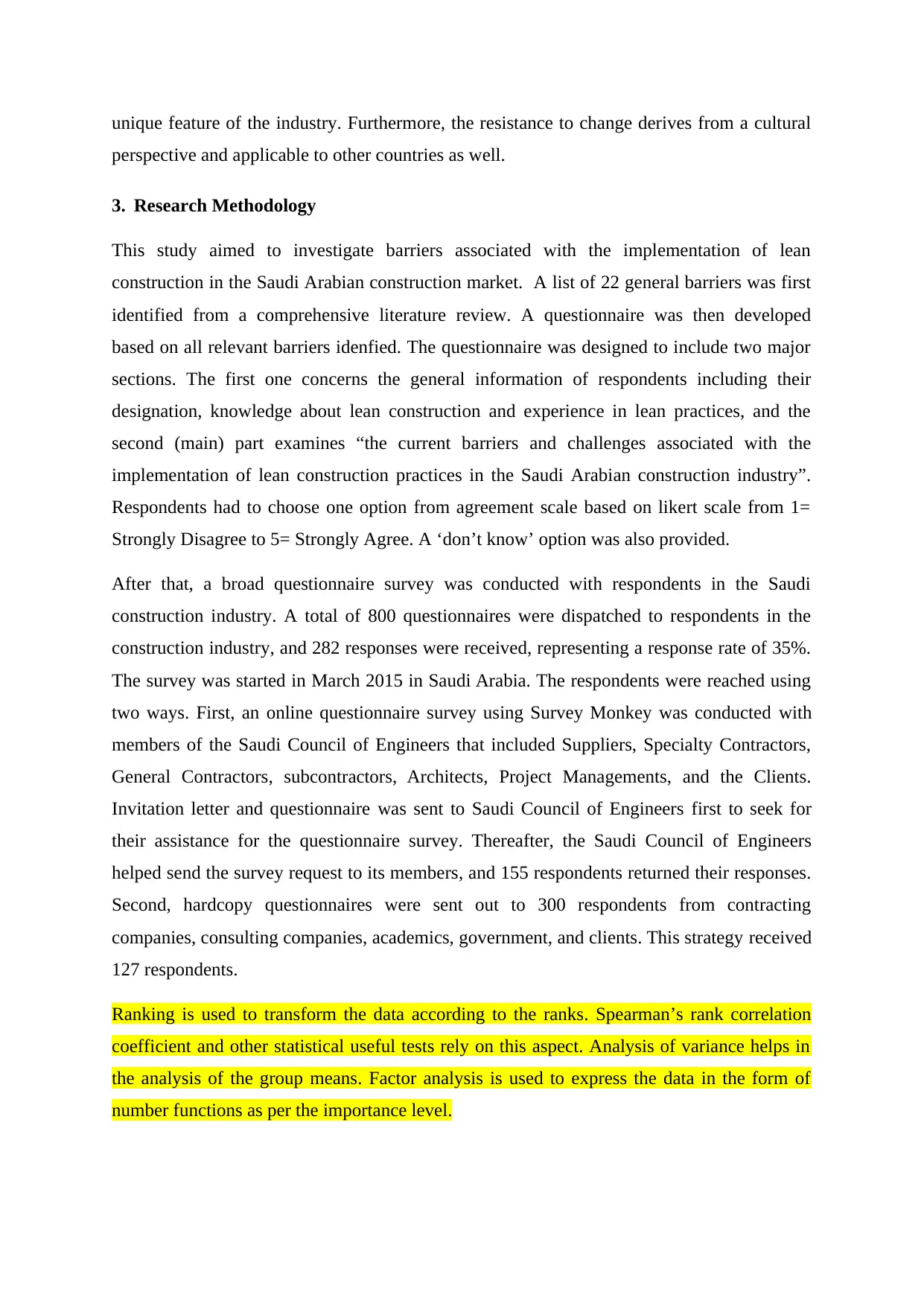
unique feature of the industry. Furthermore, the resistance to change derives from a cultural
perspective and applicable to other countries as well.
3. Research Methodology
This study aimed to investigate barriers associated with the implementation of lean
construction in the Saudi Arabian construction market. A list of 22 general barriers was first
identified from a comprehensive literature review. A questionnaire was then developed
based on all relevant barriers idenfied. The questionnaire was designed to include two major
sections. The first one concerns the general information of respondents including their
designation, knowledge about lean construction and experience in lean practices, and the
second (main) part examines “the current barriers and challenges associated with the
implementation of lean construction practices in the Saudi Arabian construction industry”.
Respondents had to choose one option from agreement scale based on likert scale from 1=
Strongly Disagree to 5= Strongly Agree. A ‘don’t know’ option was also provided.
After that, a broad questionnaire survey was conducted with respondents in the Saudi
construction industry. A total of 800 questionnaires were dispatched to respondents in the
construction industry, and 282 responses were received, representing a response rate of 35%.
The survey was started in March 2015 in Saudi Arabia. The respondents were reached using
two ways. First, an online questionnaire survey using Survey Monkey was conducted with
members of the Saudi Council of Engineers that included Suppliers, Specialty Contractors,
General Contractors, subcontractors, Architects, Project Managements, and the Clients.
Invitation letter and questionnaire was sent to Saudi Council of Engineers first to seek for
their assistance for the questionnaire survey. Thereafter, the Saudi Council of Engineers
helped send the survey request to its members, and 155 respondents returned their responses.
Second, hardcopy questionnaires were sent out to 300 respondents from contracting
companies, consulting companies, academics, government, and clients. This strategy received
127 respondents.
Ranking is used to transform the data according to the ranks. Spearman’s rank correlation
coefficient and other statistical useful tests rely on this aspect. Analysis of variance helps in
the analysis of the group means. Factor analysis is used to express the data in the form of
number functions as per the importance level.
perspective and applicable to other countries as well.
3. Research Methodology
This study aimed to investigate barriers associated with the implementation of lean
construction in the Saudi Arabian construction market. A list of 22 general barriers was first
identified from a comprehensive literature review. A questionnaire was then developed
based on all relevant barriers idenfied. The questionnaire was designed to include two major
sections. The first one concerns the general information of respondents including their
designation, knowledge about lean construction and experience in lean practices, and the
second (main) part examines “the current barriers and challenges associated with the
implementation of lean construction practices in the Saudi Arabian construction industry”.
Respondents had to choose one option from agreement scale based on likert scale from 1=
Strongly Disagree to 5= Strongly Agree. A ‘don’t know’ option was also provided.
After that, a broad questionnaire survey was conducted with respondents in the Saudi
construction industry. A total of 800 questionnaires were dispatched to respondents in the
construction industry, and 282 responses were received, representing a response rate of 35%.
The survey was started in March 2015 in Saudi Arabia. The respondents were reached using
two ways. First, an online questionnaire survey using Survey Monkey was conducted with
members of the Saudi Council of Engineers that included Suppliers, Specialty Contractors,
General Contractors, subcontractors, Architects, Project Managements, and the Clients.
Invitation letter and questionnaire was sent to Saudi Council of Engineers first to seek for
their assistance for the questionnaire survey. Thereafter, the Saudi Council of Engineers
helped send the survey request to its members, and 155 respondents returned their responses.
Second, hardcopy questionnaires were sent out to 300 respondents from contracting
companies, consulting companies, academics, government, and clients. This strategy received
127 respondents.
Ranking is used to transform the data according to the ranks. Spearman’s rank correlation
coefficient and other statistical useful tests rely on this aspect. Analysis of variance helps in
the analysis of the group means. Factor analysis is used to express the data in the form of
number functions as per the importance level.
Paraphrase This Document
Need a fresh take? Get an instant paraphrase of this document with our AI Paraphraser
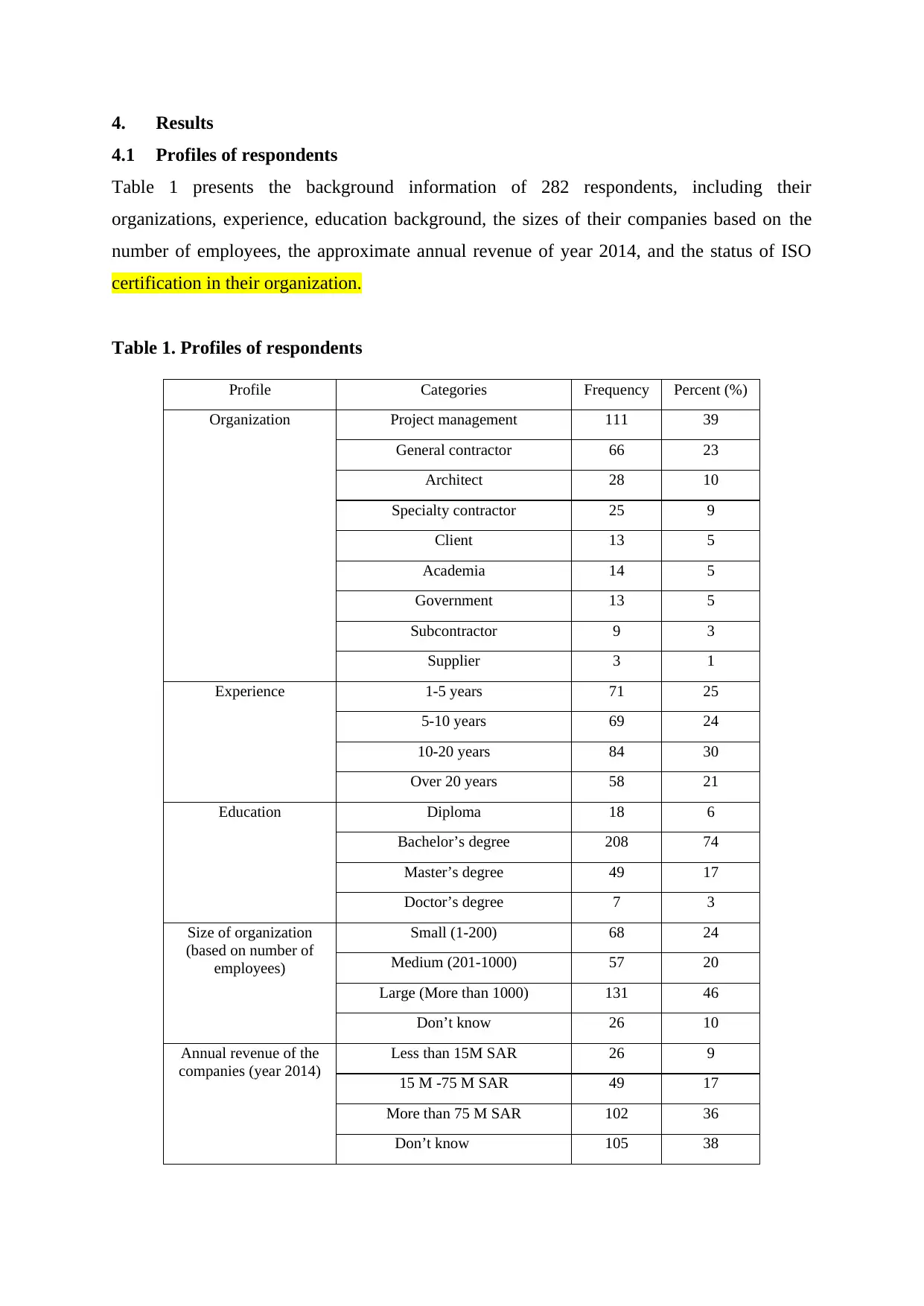
4. Results
4.1 Profiles of respondents
Table 1 presents the background information of 282 respondents, including their
organizations, experience, education background, the sizes of their companies based on the
number of employees, the approximate annual revenue of year 2014, and the status of ISO
certification in their organization.
Table 1. Profiles of respondents
Profile Categories Frequency Percent (%)
Organization Project management 111 39
General contractor 66 23
Architect 28 10
Specialty contractor 25 9
Client 13 5
Academia 14 5
Government 13 5
Subcontractor 9 3
Supplier 3 1
Experience 1-5 years 71 25
5-10 years 69 24
10-20 years 84 30
Over 20 years 58 21
Education Diploma 18 6
Bachelor’s degree 208 74
Master’s degree 49 17
Doctor’s degree 7 3
Size of organization
(based on number of
employees)
Small (1-200) 68 24
Medium (201-1000) 57 20
Large (More than 1000) 131 46
Don’t know 26 10
Annual revenue of the
companies (year 2014)
Less than 15M SAR 26 9
15 M -75 M SAR 49 17
More than 75 M SAR 102 36
Don’t know 105 38
4.1 Profiles of respondents
Table 1 presents the background information of 282 respondents, including their
organizations, experience, education background, the sizes of their companies based on the
number of employees, the approximate annual revenue of year 2014, and the status of ISO
certification in their organization.
Table 1. Profiles of respondents
Profile Categories Frequency Percent (%)
Organization Project management 111 39
General contractor 66 23
Architect 28 10
Specialty contractor 25 9
Client 13 5
Academia 14 5
Government 13 5
Subcontractor 9 3
Supplier 3 1
Experience 1-5 years 71 25
5-10 years 69 24
10-20 years 84 30
Over 20 years 58 21
Education Diploma 18 6
Bachelor’s degree 208 74
Master’s degree 49 17
Doctor’s degree 7 3
Size of organization
(based on number of
employees)
Small (1-200) 68 24
Medium (201-1000) 57 20
Large (More than 1000) 131 46
Don’t know 26 10
Annual revenue of the
companies (year 2014)
Less than 15M SAR 26 9
15 M -75 M SAR 49 17
More than 75 M SAR 102 36
Don’t know 105 38
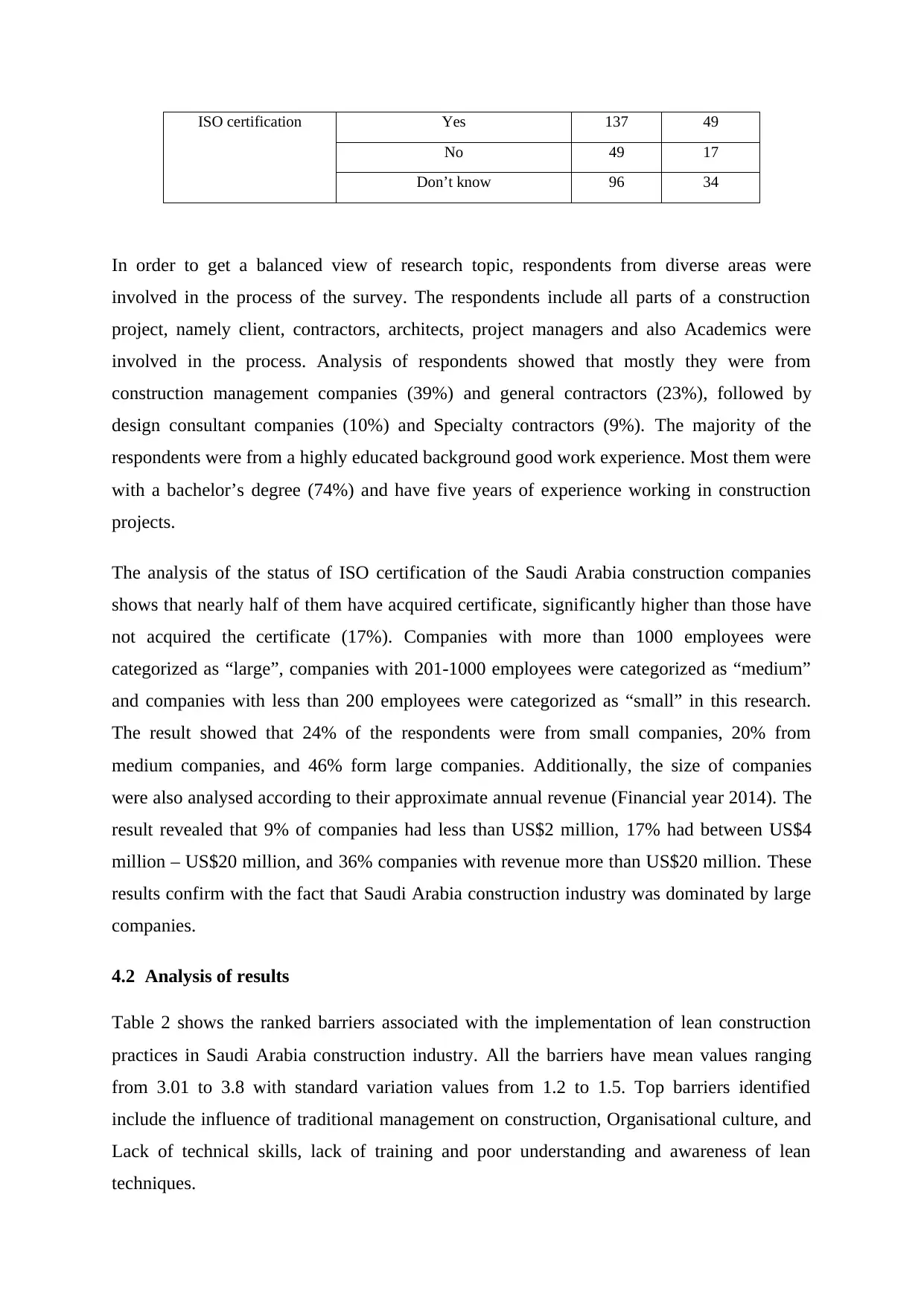
ISO certification Yes 137 49
No 49 17
Don’t know 96 34
In order to get a balanced view of research topic, respondents from diverse areas were
involved in the process of the survey. The respondents include all parts of a construction
project, namely client, contractors, architects, project managers and also Academics were
involved in the process. Analysis of respondents showed that mostly they were from
construction management companies (39%) and general contractors (23%), followed by
design consultant companies (10%) and Specialty contractors (9%). The majority of the
respondents were from a highly educated background good work experience. Most them were
with a bachelor’s degree (74%) and have five years of experience working in construction
projects.
The analysis of the status of ISO certification of the Saudi Arabia construction companies
shows that nearly half of them have acquired certificate, significantly higher than those have
not acquired the certificate (17%). Companies with more than 1000 employees were
categorized as “large”, companies with 201-1000 employees were categorized as “medium”
and companies with less than 200 employees were categorized as “small” in this research.
The result showed that 24% of the respondents were from small companies, 20% from
medium companies, and 46% form large companies. Additionally, the size of companies
were also analysed according to their approximate annual revenue (Financial year 2014). The
result revealed that 9% of companies had less than US$2 million, 17% had between US$4
million – US$20 million, and 36% companies with revenue more than US$20 million. These
results confirm with the fact that Saudi Arabia construction industry was dominated by large
companies.
4.2 Analysis of results
Table 2 shows the ranked barriers associated with the implementation of lean construction
practices in Saudi Arabia construction industry. All the barriers have mean values ranging
from 3.01 to 3.8 with standard variation values from 1.2 to 1.5. Top barriers identified
include the influence of traditional management on construction, Organisational culture, and
Lack of technical skills, lack of training and poor understanding and awareness of lean
techniques.
No 49 17
Don’t know 96 34
In order to get a balanced view of research topic, respondents from diverse areas were
involved in the process of the survey. The respondents include all parts of a construction
project, namely client, contractors, architects, project managers and also Academics were
involved in the process. Analysis of respondents showed that mostly they were from
construction management companies (39%) and general contractors (23%), followed by
design consultant companies (10%) and Specialty contractors (9%). The majority of the
respondents were from a highly educated background good work experience. Most them were
with a bachelor’s degree (74%) and have five years of experience working in construction
projects.
The analysis of the status of ISO certification of the Saudi Arabia construction companies
shows that nearly half of them have acquired certificate, significantly higher than those have
not acquired the certificate (17%). Companies with more than 1000 employees were
categorized as “large”, companies with 201-1000 employees were categorized as “medium”
and companies with less than 200 employees were categorized as “small” in this research.
The result showed that 24% of the respondents were from small companies, 20% from
medium companies, and 46% form large companies. Additionally, the size of companies
were also analysed according to their approximate annual revenue (Financial year 2014). The
result revealed that 9% of companies had less than US$2 million, 17% had between US$4
million – US$20 million, and 36% companies with revenue more than US$20 million. These
results confirm with the fact that Saudi Arabia construction industry was dominated by large
companies.
4.2 Analysis of results
Table 2 shows the ranked barriers associated with the implementation of lean construction
practices in Saudi Arabia construction industry. All the barriers have mean values ranging
from 3.01 to 3.8 with standard variation values from 1.2 to 1.5. Top barriers identified
include the influence of traditional management on construction, Organisational culture, and
Lack of technical skills, lack of training and poor understanding and awareness of lean
techniques.
⊘ This is a preview!⊘
Do you want full access?
Subscribe today to unlock all pages.

Trusted by 1+ million students worldwide
1 out of 26
Related Documents
Your All-in-One AI-Powered Toolkit for Academic Success.
+13062052269
info@desklib.com
Available 24*7 on WhatsApp / Email
![[object Object]](/_next/static/media/star-bottom.7253800d.svg)
Unlock your academic potential
Copyright © 2020–2026 A2Z Services. All Rights Reserved. Developed and managed by ZUCOL.





